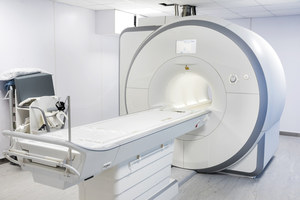 The American Cancer Society recommends an MRI, alternating with mammograms and sometimes ultrasounds, every six months for those who have more than a 20 percent lifetime risk of breast cancer. But the FDA says that some patients may be at a higher risk for gadolinium retention, including “those requiring multiple lifetime doses, pregnant women, children and patients with inflammatory conditions.”
The American Cancer Society recommends an MRI, alternating with mammograms and sometimes ultrasounds, every six months for those who have more than a 20 percent lifetime risk of breast cancer. But the FDA says that some patients may be at a higher risk for gadolinium retention, including “those requiring multiple lifetime doses, pregnant women, children and patients with inflammatory conditions.”Gadolinium and the FDA
In December 2017, the FDA issued a drug safety communication for certain types of contrast agents, providing new information about the risk of gadolinium retention and potential side effects. As a result, manufacturers were required to provide new warnings and information in a Medication Guide, which all patients receiving an MRI contrast dye are asked to read.
The European Medicines Agency (EMA) has gone a step further: it recommends that most linear GBCAs be withdrawn from the market. Linear agents are thought to be riskier as they stay inside human tissue rather than escape by flushing through the kidneys.
Gadolinium MRI Lawsuits
The latest lawsuit joins many others alleging similar problems, including bone and joint pain, severe cognitive issues, skin problems, and other symptoms associated with a condition known as Gadolinium Deposition Disease. Retention is no longer associated only with individuals with compromised kidney function: Previous lawsuits linked gadolinium to an increased risk of nephrogenic systemic fibrosis with kidney-disease patients.
Recent MRI gadolinium lawsuits allege that the manufacturers knew, or should have known, about the risks associated with their products, but failed to provide adequate warnings for patients or the medical community.
Cheryl Mahnke filed a product liability lawsuit in the U.S. District Court for the Northern District of California on May 13 against Bayer Health Care, McKesson Medical-Surgical Inc (the distributor of Magnevist and other GBCAs) and other defendants claiming failure to warn, defective design, misrepresentation, negligence, fraud and consumer protection violations. (Case 3:19-cv-02553)
Bayer manufactures and markets older gadolinium contrast dyes known as linear GBCAs, including Magnevist, Eovist, and Gadavist. Mahnke claims she was exposed to Magnevist more than 20 times since 2010, which is one of the oldest contrast dyes on the market.
Gena Norris, the wife of actor Chuck Norris, filed a lawsuit against several health companies in 2017 claiming the contrast dye used during an MRI testing for rheumatoid arthritis caused gadolinium deposition disease. According to the Washington Post, the Norrises are seeking more than $10 million in damages from companies they say should have warned them of risks. After undergoing three contrast-enhanced MRIs within a week, Gena Norris developed a burning pain throughout her body and experienced violent shaking, numbness and tingling, and weakness, according to their lawsuit. More recent symptoms include cognitive deficits, kidney damage and trouble breathing.
Last November, Radiology Business published “Gadolinium: Actual Offender or Unwitting Pretender?” that again questions whether to be safe than sorry. Sharon Williams, with the patient advocacy group Lighthouse Project, developed a rash on her lower legs some 18 days after her fifth dose of contrast and said her brain “feels like it has been cut in half with frequent pain on the left side and non-stop, 24/7 pressure on the right side.”
Gadolinium Studies
A number of studies are currently attempting to determine the biological activity of gadolinium that gets left behind, and increasingly, radiologists are listening to MRI patients about the risks of gadolinium retention.
READ MORE MRI HEALTH RISK LEGAL NEWS
Studies have found that traces of gadolinium deposition can remain in brain tissue for years after administration of MRI contrast dye. “This effect bears continued watchfulness,” Robert McDonald, a neuroradiologist at the Mayo Clinic told Radiology Business, “but we are at risk of causing fear-mongering, which does not benefit us as providers or our patients. I now have patients who are so fearful of getting gadolinium contrast that they’re willing to compromise their health.”

READER COMMENTS
Joann Lijek
on
He came home but never really recovered and his liver disease progressed to liver cancer and he was dead a year later.
He was not that sick before the doctors got a hold of him and started all their imaging. He would also be really sick from CT scans.
I tried talking to the doctors about the contrast so they stopped doing it, but also told me it was perfectly safe.
My husband died in 2012 so I may not remember all the details.
starla hawkins
on
JOI L SINGLETON
on
Donna Mistek
on